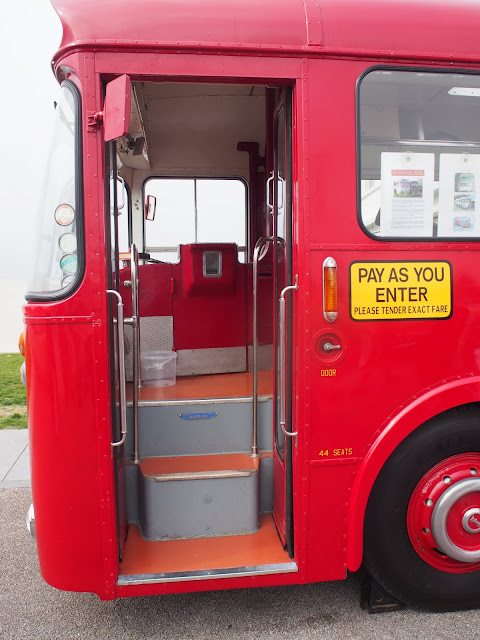However, the recent Vintage by the Sea Festival in Morecambe provided a reminder of just how far the bus industry has come.
Present at the Vintage Festival was this bus, built in 1966, which was fairly typical of single-deck buses operating at that time and for many years later. This example was owned by Ribble Motor Services of Preston and similar buses would have been used on services throughout the Lancaster District. Boarding a bus like this was not exactly easy, even if you had no mobility problems.
Some bus entrances were even less inviting, as this example from Scotland shows:
By the 1980s some progress had been made, but boarding a bus was still not exactly easy for the less than perfectly-mobile even in the 1980s and 1990s.
The "Leyland National" was built in Workington between 1972 and 1985 and was the standard single-decker bus for the state-owned National Bus Company. Examples were operated by both Ribble and Lancaster City Transport. Whilst obviously an improvement on earlier types it was still not particularly easy to board and completely unable to cater for wheelchair users. Nevertheless examples continued to be used in service throughout the remainder of the 20th Century.
The wheelchair space on modern buses is widely used by people with pushchairs containing small children. It's worth reflecting just what catching a bus entailed for such passengers in the days before accessibility became standard and especially once conductors had disappeared from buses with the spread of one-person-operation. The sequence went something like this:
2. As bus approaches, put down bag, take baby out of pushchair and whilst holding baby in one arm use other arm to fold pushchair before transferring it to first arm.
3. Carrying baby and pushchair in one arm, use other arm to pick up shopping bag and board the bus via several steep steps.
4. Whilst balancing baby and pushchair in one arm, furtle in shopping bag to retrieve purse and pay fare, making sure to put the ticket away safely in case an Inspector gets on and wants to see it.
5. Carrying baby, place pushchair in luggage bay, then find a seat and place baby safely on lap for duration of journey.
6. On approaching alighting stop, ring bell then gather up baby and shopping bag and make way to front of the bus (before it reached the stop so as not to delay everyone's journey). With free hand, pick up pushchair and make way down several high steps to the pavement.
7. Whilst holding baby in one arm use other to unfold pushchair. Place baby in pushchair, retrieve shopping bag and proceed on way.
8. Repeat as required whenever travelling by bus!
Whilst things were difficult for "mums and babies" they were, of course, impossible for wheelchair users or even anyone unable to climb steps. Such people were simply not expected to travel by bus.
Fortunately things are much better nowadays and a modern bus entrance looks more like this:
The modern bus has a single-step entrance, which can be lowered, as well as a fold-out ramp to allow passengers in wheelchairs to board and alight.
But all is not perfect. Inside the bus is a dedicated area for wheelchairs. This is designed so that wheelchair-users can access it independently and travel safely. The Accessibility Regulations that require low-floor buses in the first place also determine the design of the wheelchair area.
Because of the need for users to access the area without assistance there are no restraints or clamps to hold a chair in place: for that passengers rely on the chair's own braking system. Because passengers travel backwards (for safety reasons) but need to leave the bus facing forwards, the angled yellow pole is provided to assist them in manoeuvring the chair in and out of the wheelchair area. Some passengers, however, find this impedes rather than helps them and the lack of a restraint system does concern other users.
The Bus Users' Group is always interested to learn how the lot of all bus passengers can be improved, including those who rely on a wheelchair to get around. The current systems have been in place now for almost fifteen years and it would not be surprising if someone thought they had come up with a better approach.
One such person is Helen Dolphin. Helen is a disability campaigner and sits on The Disabled Persons Transport Advisory Committee (DPTAC), She is Chair of her local Driving Mobility centre, sits on the Consumer Panel for the Civil Aviation Authority and runs a pan disability organisation called The Joint Committee for the Mobility of Disabled People (JCMD).
Helen is an advocate for the Quantum system of catering for wheelchairs on buses which, she says, many users would find more acceptable.
The Quantum system incorprates an automatic restraint system providing that degree of security that many passengers seek. We are very pleased to welcome Helen to speak about the system as well, no doubt, on other issues facing disabled passengers at our next meeting, which is being held on Wednesday, 18th September at The Cornerstone, Sulyard Street, Lancaster starting at 3.15pm. The meeting is open to everyone.











